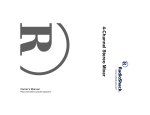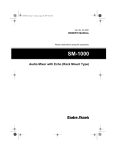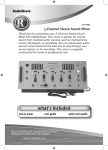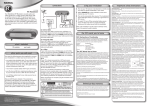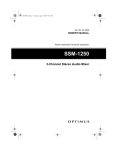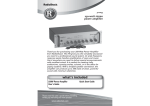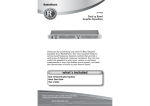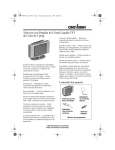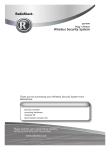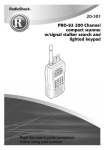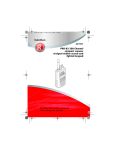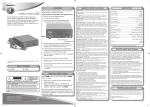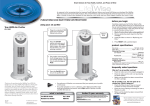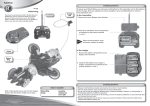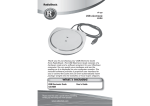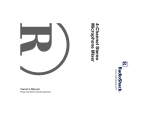Download Radio Shack 32-2058 User`s guide
Transcript
32-2058 4-Channel Audio Mixer with 3 Band EQ Controls & Echo Your RadioShack 4-Channel Audio Mixer with 3 Band EQ Controls & Echo is perfect for mixing sound from multiple playback sources such as a microphone, tuner, CD player, turntable, or the audio output from a VCR. It is ruggedly constructed for home or professional use. Its volume controls let you adjust sound for playing through your speaker system or for recording. Thank you for purchasing your 4-Channel Audio Mixer from RadioShack. what’s included mixer user’s guide Please read this user’s guide before installing, setting up and using your new product www.radioshack.com quick start guide The Basics contents connections ............................................... 6 using your mixer ...................................... 9 mixing inputs ......................................... 13 using a microphone ................................ 15 using the special controls ....................... 16 using echo .............................................. 18 frequently asked questions .................... 20 replacing the fuse ................................... 21 specifications ........................................... 22 2 The Basics IMPORTANT SAFETY INSTRUCTIONS Read Instructions — All safety and operating instructions should be read before the appliance is operated. Retain Instructions — The safety and operating instructions should be retained for future reference. Heed Warnings — Follow all warnings on the appliance and in the operating instructions. Cleaning — Unplug this appliance from the wall outlet before cleaning. Use only a damp cloth for cleaning. Do not use liquid or aerosol cleaners. Water and Moisture — Do not use this appliance near water (for example, near a bathtub, washbowl, kitchen sink, or laundry tub; in a wet basement; or near a swimming pool). Mounting Accessories — Do not place this appliance on an unstable cart, stand, tripod, bracket, or table. The appliance may fall, causing serious injury to a child or adult, and serious damage to the appliance. Use only with a cart, stand, tripod, bracket, or table recommended by the manufacturer or sold with the appliance. Follow the manufacturer’s instructions for mounting, and use a recommended mounting accessory. Ventilation — Slots and openings in the cabinet provide ventilation, ensure reliable operation, and protect from overheating. Do not block or cover these openings, and do not place the appliance on a bed, sofa, rug, or other similar surface. Do not place the appliance in a built-in installation such as a bookcase or rack unless it provides proper ventilation as specified by the manufacturer. Heat — The appliance should be situated away from heat sources such as radiators, heat registers, stoves, or other appliances (including amplifiers) that produce heat. Power Sources — Operate this appliance only with the power source indicated. If you are not sure of your home’s power type, consult your appliance dealer or power company. Polarized Power Cord Plug — This appliance is equipped with a polarized power cord plug (a plug having one blade wider than the other). This plug will fit in the power outlet only one way. This is a safety feature. If you cannot insert the plug fully into the outlet, 3 The Basics try reversing the plug. If the plug still doesn’t fit, contact your electrician to replace your obsolete outlet. Do not defeat the safety purpose of the polarized plug. Power-Cord Protection — Route power-supply cords so they are not likely to be walked on or pinched by items placed on or against them, paying particular attention to cords at plugs, convenience receptacles, and the point where they exit from the appliance. Cleaning — The appliance should be cleaned only as recommended by the manufacturer. Wipe it with a cloth slightly dampened with water. Avoid getting water inside the appliance. Power Lines — An outside antenna system should not be located in the vicinity of overhead power lines or other electric light or power circuits, or where it can fall into such power lines or circuits. When installing an outside antenna system, extreme care should be taken to keep from touching such power lines or circuits as contact with them might be fatal. Nonuse Periods — The power cord of the appliance should be unplugged from the outlet when the appliance is to be left unused for a long period of time. Overloading — Do not overload wall outlets, extension cords, or integral convenience receptacles, as this can result in a risk of fire or electric shock. Objects and Liquids — Never push objects of any kind into this appliance through openings, as they may touch dangerous voltage points or short out parts that could result in a fire or electric shock. Never spill liquid of any kind on the appliance. Carts and Stands — If the appliance is used with a cart or stand, the cart/stand type should be recommended by the manufacturer. An appliance and cart combination should be moved with care. Quick stops, excessive force, and uneven surfaces cause the appliance and cart combination to overturn. Mounting — The appliance should be mounted only as recommended by the manufacturer. Damage Requiring Service — Unplug this appliance from the wall outlet and refer servicing to qualified service personnel under the following conditions: 4 The Basics * When the power-supply cord or plug is damaged. * If liquid has been spilled or objects have fallen into the appliance. * If the appliance has been exposed to rain or water. * If the appliance does not operate normally by following the operating instructions. Adjust only those controls that are covered by the operating instructions, as an improper adjustment of other controls may result in damage and will often require extensive work by a qualified technician to restore the appliance to normal operation. * If the appliance has been dropped or damaged in any way. * When the appliance exhibits a distinct change in performance. Servicing — Do not attempt to service this appliance yourself, as opening or removing covers may expose you to dangerous voltage or other hazards. Refer all servicing to qualified service personnel. Replacement Parts — When replacement parts are required, be sure the service technician has used replacement parts specified by the manufacturer or have the same characteristics as the original part. Unauthorized substitutions may result in fire, electric shock or other hazards. Safety Check — Upon completion of any service or repairs to this appliance, ask the service technician to perform safety checks to determine that the appliance is in proper operating condition. Lightning — For added protection for this product during a lightning storm, or when it is left unattended and unused for long periods of time, unplug it from the wall outlet. This will prevent damage to the product due to lightning and power line surges. Attachments — do not use attachments not recommended by the product manufacturer as they may cause hazards. Wall or Ceiling Mounting — The product should be mounted to a wall or ceiling only as recommended by the manufacturer. 5 The Basics connections A sudden high output from the mixer could damage your hearing or damage the audio devices connected to your mixer. Before connecting to AC power, turn off your mixer and all audio devices connected to your mixer. connecting outputs OUTPUT AMP L/R — use an audio patch cord (not supplied) to connect your receiver or amplifier to your mixer (match left to left, right to right). The sound is output to your stereo sound system. OUTPUT AMP L/R — use an audio patch cord (not supplied) to connect your receiver or amplifier to your mixer (match left to left, right to right). The sound is output to your stereo sound system. 6 The Basics connecting inputs LINE 1, 2, 3, 4, 5, 6 — connect up to six audio AUX LINE MONO — connect a mono input source here. sources to your mixer. Do not connect audio sources with line-level outputs to the PHONO 1, PHONO 2, or AUX MIC jacks. GND EFFECT SEND/RECEIVE — connect a sound effect device to EFFECT SEND (output) and EFFECT RECEIVE (input). AUX MIC — connect a microphone with a 1 /4-inch plug here. PHONO 1/2 — connect up to two low-level audio sources to your mixer. If you connect a magneticcartridge turntable, connect its ground wire to GND. connecting power Connect the mixer’s power cord to a standard AC outlet. 7 The Basics connecting a lamp, headphones and mic DJ MIC — connect a microphone 12V/3W MAX LAMP — connect a 12V with an XLR plug here. DC/3W BNC lamp (not supplied) to light up the mixer’s controls. PHONES — connect a pair of stereo headphones (not supplied) with a 1/4-inch plug. You can then listen and locate a section of music to mix. listening safely Do not listen at extremely high volume levels. Extended, high-volume listening can lead to permanent hearing loss. To protect your hearing when using headphones, always follow these guidelines to set the listening volume: • Set CUE LEVEL (headphones volume) to minimum before putting on your headphones. • After you put on the headphones, adjust CUE LEVEL to a comfortable listening level. Do not increase the CUE LEVEL setting. Over time, your ears adapt to the volume level. 8 The Basics using your mixer 1. Set your output device’s volume to minimum and turn it on. 2. Press POWER to turn on the mixer. 3. Turn on the audio input sources you want to mix. 4. Preset the input signal levels (see “presetting input signal levels”). 5. Mix the audio input sources (see “mixing the inputs” on Page 13). 6. When you are finished, turn off all connected audio devices (amplifiers, tape decks, and so on), and press POWER to turn off the mixer. presetting input signal levels To avoid overdriving a channel or prematurely mixing an audio input source, adjust your mixer to these settings: 1. Rotate MASTER clockwise about halfway. 2. Press MONO/STEREO in for monaural output. Press again for stereo output. 3. The mixer’s LED meters show total stereo output level. For best results, input signal levels should be set so the meters read 0db or less. 9 The Basics All HIGH, MID, and BASS controls to 0. SEND, RECEIVE, and MASTER set to 0. All GAIN controls set midway between MIN and MAX. DJ MIC LEVEL and AUX LEVEL to 0. CUE LEVEL to 0. CH1, CH2, CH3, and CH4 to 0. SEND ASSIGN and CUE ASSIGN to OFF. presetting audio inputs Before mixing your audio sources (devices connected to LINE 1, PHONO 1, PHONO 2, LINE 2, LINE 3, LINE 4, LINE 5, LINE 6), you must set their input signal level to each channel input (CH1, CH2, CH3, etc.). You do not have to mix every connected input source. 1. Set the channel selector to the desired input source. 2. Play the selected input source. 3. Adjust HIGH, MID, and BASS as desired. See “using the special controls” on Page 18. If you are using an external equalizer, leave the controls set to 0 and adjust the tone on the external equalizer. 4. Adjust the volume on your headphones (CUE LEVEL) or receiver to a comfortable listening level. 10 The Basics 5. Slowly slide up the channel volume control (CH) until you get a reading of up to 0 dB on both LED meters. 6. Stop playback of the selected input source. 7. Repeat steps 1-7 for each audio input you plan to mix. Notes: • Write down the CH setting for each audio source. Then, when you want to mix that source, you can adjust its volume to that setting. • If it was necessary to set CH 1 to maximum to get a reading of 0 dB or less on the LED meter, slide CH 1 down to about 8 and adjust MASTER upward until you get a reading of 0 dB on both LED meters. If that does not work, set GAIN midway and rotate MASTER clockwise until you get a reading of 0 dB on the LED meters. presetting microphone(s) 1. If your microphone has an ON/OFF control, turn it ON. Otherwise, set DJ MIC LEVEL or AUX LEVEL to 0. DJ MIC LEVEL AUX LEVEL 11 The Basics 2. While talking, adjust DJ MIC LEVEL or AUX LEVEL until you get a reading of less than 0 dB on both LED meters. See “using an XLR microphone” on Page 16. Notes: • Write down the DJ MIC LEVEL or AUX LEVEL setting. Then, when you want to mix with the microphone, you can adjust it to this setting. • If it was necessary to set DJ MIC LEVEL or AUX LEVEL to 10 in order to get a reading less than 0 dB on the LED meter, adjust either one to 8 and adjust DJ MIC GAIN to get a reading less than 0 dB on the LED meters. See “gain” on Page 18. • If the above suggestion does not work, set DJ MIC GAIN or AUX GAIN to about 5 and rotate MASTER clockwise until you get a reading less than 0 dB. Remember that adjusting MASTER affects the level of the previously set input sources. You must readjust those sources accordingly. 12 Beyond the Basics mixing inputs You can select any two of your connected audio sources and mix them so one or both play through your sound system. Mixing consists of three parts: playing an input source, monitoring a second input source, and switching to a second input source. playing an input source 1. Set ASSIGN A to the desired audio source (1, 2, 3, 4 correspond to CH 1, CH 2, CH 3, CH 4). PHONO 1/LINE 1 PHONO 2/LINE 2 LINE 3/LINE 4 LINE 5/LINE 6 CROSS FADER ASSIGN A and ASSIGN B CUE ASSIGN CUE LEVEL 2. Slide CROSS FADER all the way to A. 3. Select the mixer’s input -- CH 1, CH 2, CH 3, or CH 4. 4. Set PHONO 1/LINE 1, PHONO 2/LINE 2, LINE 3/LINE 4, or LINE 5/LINE 6 to the preset input source you are going to play first. 5. Adjust the input source’s volume to it’s preset signal level (see “presetting input signal levels” on Page 10). 6. Play the source. 13 Beyond the Basics monitoring a second input source Monitoring a second input source requires listening to an input source, finding the desired audio section you want to mix, and adjusting it’s sound level to match the volume of the first input source (the one designated ASSIGN A). 1. Connect and put on headphones. You can listen to one source through the headphones while the other source plays over the sound system. 2. Set ASSIGN B to the second input source (1, 2, 3, 4 correspond to CH 1, CH 2, CH 3, CH 4). 3. Set CUE ASSIGN to the audio input source (1, 2, 3, 4). 4. Set PHONO 1/LINE 1, PHONO 2/LINE 2, LINE 3/LINE 4, or LINE 5/LINE 6 to the second input source. 5. Play the second input source. 6. Adjust the second input source’s volume (CH) to it’s preset signal level. If using headphones, adjust CUE LEVEL (headphones volume) to a comfortable listening level. 7. Stop or pause play when you reach the section of music to mix. switching to a second input source 1. Play the second input source. 2. When you are ready to hear it play on your sound system, slide CROSS FADER from A to B. 3. Slide CROSS FADER to the left to fade in ASSIGN A (source one) and fade out ASSIGN B (source two). Slide CROSS FADER to the right to fade in ASSIGN B and fade out ASSIGN A. Slide CROSS FADER to the center to equally mix the two. • Do not slide CROSS FADER to the center when monitoring a channel while another is playing. Instead, slide CROSS FADER to the channel you are not monitoring. For example, to monitor channel 1 (ASSIGN A) while channel 2 (ASSIGN B) is playing, slide CROSS FADER to B. 14 Beyond the Basics using a microphone using an XLR microphone To mix the XLR microphone with other audio input sources, adjust DJ MIC LEVEL to increase or decrease microphone volume. Set DJ MIC LEVEL to 0 when you are not using the DJ microphone. using the AUX microphone To mix the AUX microphone with other audio input sources, set AUX MIC/LINE to MIC. Adjust AUX LEVEL to increase or decrease microphone volume. When you are not using the AUX microphone, set AUX MIC/LINE to LINE. When set to LINE, you can mix the output from the device connected to the AUX LINE MONO jack. using talkover Press TALK OVER to reduce audio input sound so that the microphone output is heard over the music. Rotate MUTE LEVEL to adjust the background music volume while using talkover. Press TALK OVER again to turn it off. All audio inputs, including the microphones, play at the same output level. PAN To play either microphone or the AUX LINE output on the left or right channel, adjust the DJ or AUX PAN control. Turn it to L to play through the left channel, to R to play through the right channel, or to any other position between L and R to balance sound through both channels. 15 Beyond the Basics using the special controls tone Your mixer has a set of tone controls for each microphone and channels 1– 4. You can tailor the high, middle, and low frequency sounds for each. For normal sound, leave BASS, MID, and HIGH set to 0. Rotate HIGH, MID, or BASS toward +10 to increase, or toward –10 to decrease the high, middle, and low frequency sounds. gain Since the input level of each source is different, you can use GAIN to fine tune each input’s volume. Rotate the desired GAIN control toward MAX to increase the volume and toward MIN to reduce it. DJ MIC LEVEL AUX LEVEL AUX MIC/LINE TALK OVER BALANCE MUTE LEVEL PAN We recommend adjusting GAIN before presetting the inputs since some sound imbalance could occur. 16 Beyond the Basics setting the sound balance BALANCE lets you adjust the sound balance between the left and right speakers. If your speakers are properly positioned and your listening area is centered between the speakers, the center setting of the control is usually the best. If the sound seems to be louder from one speaker, adjust BALANCE until the output sounds equally from both speakers. 17 Beyond the Basics using echo The mixer plays echo effects, and lets you adjust echo delay, number of echo repeats, and the echo’s volume. The echo is applied to the sound before all the inputs are mixed. 1. Set ECHO to MIC to apply the echo effect to the microphones and AUX LINE input. 2. Set ECHO to MUSIC to apply the echo effect to the channel outputs. 3. Set ECHO to OFF to turn off the echo effect. adjusting echo delay, repeat, and volume ECHO DELAY lets you adjust the time interval between echoes. Set ECHO DELAY to 0 for minimum delay, and to 10 for maximum time delay. ECHO REPEAT lets you control the length of time a tone is repeated (reverberation). Set ECHO REPEAT to 10 for the longest time repeat and to 0 for the shortest. ECHO LEVEL lets you adjust the echo output level. Rotate ECHO LEVEL toward 10 to increase the echo level, and toward 0 to decrease it. playing the signal from the sound effect device To play signals from the device connected to the EFFECT jacks, set RECEIVE to ON. Rotate RECEIVE to adjust the volume of the device connected to the EFFECT jacks without changing the sound effect device’s volume. Rotate RECEIVE toward 10 to raise the volume and toward 0 to decrease it. When you are not using the connected inputs, set RECEIVE to OFF. 18 Beyond the Basics playing input signals through the sound effect device You can play inputs selected by the channel selectors (DJ MIC or AUX) through other sound effect devices connected to the mixer, and control playback through the mixer. To play selected inputs through the sound effect device, set SEND ASSIGN to the selected input. SEND lets you adjust the volume of the selected sound effect device without changing the device’s volume. Rotate SEND toward 10 to raise the volume and toward 0 to decrease it. 19 Beyond the Basics frequently asked questions Q - I set up my mixer using the instructions. Why doesn’t it work? A - Make sure you are connected to a “live” AC outlet. - Verify that all sources are securely connected. - Check the fuse and replace it if needed. Q - Why is there no signal from my input source? A - Make sure TALK OVER is turned OFF. - Make sure the input source is turned on. - Check the mixer and source control settings. - Check connections between the mixer and input source. Q - Why do I hear a humming noise from the PHONO source? A - Make sure the PHONO 1 or PHONO 2 source’s ground wire is connected to the mixer’s GND terminal. Q - Why do I hear a humming noise from another input source? A - Make sure there are no low-level inputs connected to the mixer’s LINE input jacks. Q - Why am I getting microphone feedback (squealing)? A - Move the microphone further away from the output speakers or use a directional microphone. care Keep the mixer dry; if it gets wet, wipe it dry immediately. Use and store the mixer only in room temperature environments. Handle the mixer carefully; do not drop it. Keep the mixer away from dust and dirt, and wipe it with a damp cloth occasionally to keep it looking new. service and repair If your mixer is not performing as it should, take it to your local RadioShack store for assistance. To locate your nearest RadioShack, use the store locator feature on RadioShack’s website (www. radioshack.com), or call 1-800-The Shack (843-7422) and follow the menu options. Modifying or tampering with the mixer’s internal components can cause a malfunction and might invalidate its warranty. 20 Beyond the Basics replacing the fuse The mixer uses a fuse for protection against surges and short circuits. If the mixer suddenly turns off and will not turn on, check the fuse. If necessary, replace it with a 0.5-amp, 250volt, fast-acting, 11/4 x 1/4 inch fuse (not supplied). 1. Disconnect power from the mixer. 2. Use a Philips screwdriver to remove the fuse compartment cap. 3. Remove the old fuse and insert a new one. Make sure you replace the fuse only with another fuse of the same type and rating. 4. Replace the fuse compartment cap. 5. Reconnect the mixer to power. 21 Beyond the Basics Specifications Input Sensitivity/Impedance DJ MIC (XLR jack) .............. 1.5mV, 600 ohms, balanced/unbalanced AUX MIC (Phone jack) ........................1.5mV, 600 ohms, unbalanced Phono ........................................................................ 3mV/50 kOhms Line ....................................................................... 150 mV/27 kOhms Output Level Main Out ....................................................................... 2V/10 kOhms Record ................................................................... 150 mV/10 kOhms Send ..................................................................... 150 mV/10 kOhms Frequency Response ............................................ 20~20k Hz +3 dB S/N Ratio Mic ............................................................................................ 55 dB Phono ........................................................................................ 65 dB Line ............................................................................................ 75 dB Distortion Mic ........................................................................................... 0.20% Phono ....................................................................................... 0.08% Line ........................................................................................... 0.08% Tone Control, DJ MIC, AUX, CH 1, CH 2, CH 3, CH4 HIGH Boost/Cut Range .............................................±10dB at Center MID Boost/Cut Range .............................................. ±10dB at Center BASS Boost/Cut Range ........................................... ±10dB at Center ECHO Delay Time ............................................................. 50~120ms TALK OVER Attenuation ................................................. –8 to –38 dB Power Source ............................................... AC 120V, 60Hz, 20-Watt Power Fuse ...................................................................... 0.5A/250 V Dimensions (HWD) .......................................... 47/16 x 19 x 11 inches (113 x 482 x 280 mm) Weight .................................................................... 11.35 Ibs 182 oz. (5.15 kg) Specifications are typical; individual units might vary. Specifications are subject to change and improvement without notice. 22 Beyond the Basics 23 accessories Depending on how you plan to use your mixer, some or all of the following items may be purchased separately: audio patch cord microphone with an XLR plug (DJ mic) microphone with 1/4-inch plug stereo headphones 12V lamp bulb limited one year warranty This product is warranted by RadioShack against manufacturing defects in material and workmanship under normal use for one (1) year from the date of purchase from RadioShack company-owned stores and authorized RadioShack franchisees and dealers. For complete warranty details and exclusions, check with your local RadioShack store. RadioShack Customer Relations 200 Taylor Street, 6th Floor, Fort Worth, TX 76102 04/04 Printed in China 32-2058 07A04 ©2004. RadioShack Corporation. All rights reserved. RadioShack and RadioShack.com are trademarks used by RadioShack Corporation.
























